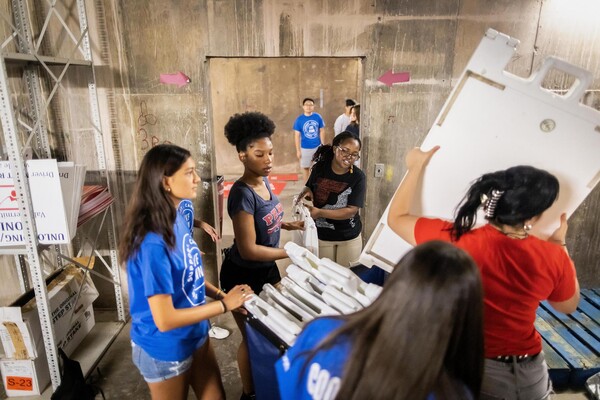"You find yourself maybe stretching the envelope of what you thought you were capable of."
Kaminsky in front of the Gazela Primeiro, the oldest, largest wooden square-rigger still sailing in the world.
Photo by Candace diCarlo
NAOMI KAMINSKY
Position:
Publications Coordinator, College of Arts and Sciences
Length of service:
9 yearS
Other stuff:
Owns and maintains her own 25-foot sloop; writes about sailing; takes courses for the pleasure of it.
When Naomi Kaminsky decided that she wanted a job at Penn in the midst of a hiring freeze, she taught herself word processing in four days, told a temp agency she'd work only at Penn, and got a placement for a month in the College. At the end of the month, they asked her to stay.
But she had plans for the next month - to sail. "That kind of got them clued in early," she said.
Q. What do you enjoy about sailing?
A. One thing is just the immediacy. It's hard for your brain to drift too far in the past and much further in the future than, "Is there a front coming in or is there a tugboat bearing down on me."
It's a connection with the elements around me that is different from anywhere else I go. It's much more connnected to the wind, to the water, to what's happening. In most cases it's a slow enough pace so you have time to notice, and just when you've been lulled into complacency, you have that moment of terror that keeps you alert. And for me, too, I came to it kind of late. I'm almost 50. And a lot of people I know started sailing when they were little children or young teenagers, so they've fallen out of boats, they've had all those adventures that a 50-year-old woman doesn't really want.
So, I'm pleased with myself. I'm proud of having come to it relatively late. I don't see a lot of women on the river sailing their own boats.
That's pretty much what I like about small boat sailing. But when you sail Gazela [Primeiro, a three-masted barkentine], it's a vastly different experience.
Q. How is it different?
A. On a small boat, you're the captain, you're the crew, you're the cook to take the blame or congratulate at the end of the day. In a crew of 35, you're part of the machinery that the captain uses to get from point A to point B. And while you have a lot of personal fulfillment in that, it's pretty much the fulfillment of doing a good job, interacting in a positive and productive manner with other crew members that you might not necessarily invite home for dinner or you might not want to sit and have beer with at the end of a sail, but your life and the safety of the vessel may depend on how well you interact with that person. And that's not something we find ourselves having to do very often, relying really on a life basis on somebody that we don't necessarily choose, so you really have to put your private oddities and preferences aside for the safety and well-being of the whole. And to the extent that I find myself doing that, I feel as though I've learned valuable lessons.
There's always that element of terror on the ship, as well, when a storm hits and you find yourself maybe stretching the envelope of what you thought you were capable of. I work on the bowsprit a lot. I'm the logical person to call on if the fun hits the fan and we get into a blow and have to take those sails.
Q. Is that scary?
A. That's one of the scary parts. And chances are if you fall off there, you're not going to be splattered on the deck; you're going to be run over by the ship. I do a little ritual every time I go out to work there, particularly in heavy weather. I focus just for a split second on humility, and then I go out. I've gone out on the very end when the ship is pitching, and the arc is just enormous. You come back in and you feel grateful about being back in the ship, you feel good about having done the task that you were asked to do, and then in the back there's a little, "Maybe I just brought my whole game up a notch."
Q. Do you sail all year?
A. I was fortunate enough about six years ago to be introduced almost as a blind sailing date to a professor emeritus at Penn named Britton Chance. I was going to Florida to take photographs of boats just for fun and somebody said, I'm sure Dr. Chance would really like to have a picture taken of his boat. I contacted him, and one thing led to another and for the next five years, he flew me down to Marathon in the Keys to crew with him every winter and to help him with his boat. He was enormously helpful and wonderful about sharing his boat and his knowledge. He was an Olympic gold medalist in Helsinki. So that was a lot of why I even thought I might buy a boat.
Q. Can anyone volunteer to join the Gazela crew?
A. You do not have to know anything. We teach everything from knots to how to fall in line. We have everything from age 16 to a gentleman who just came on who's 80.You get a 16-year-old and a 60-year-old on lookout in the middle of the night, and one doesn't have a clue at the beginning that they'll have anything in common with the other, and by the end of the trip they're starting to see each other as peers rather than as being the grandmother that they have to go visit, and what they find is a common denominator is very often the spirit that brought them to the ship, the spirit of adventure, the spirit of stretching their own experiences and doing something out of the norm.
Want to crew on Gazela when she sails with OpSail 2000, a tall ship parade starting in San Juan and sailing up the East Coast? Naomi will hold an information session for students, faculty and staff Tuesday, Dec. 1, 6 to 8 p.m. in the conference room in Logan Hall. For information about Gazela, call (215) 218-0110 or visit the Gazela Web site.







